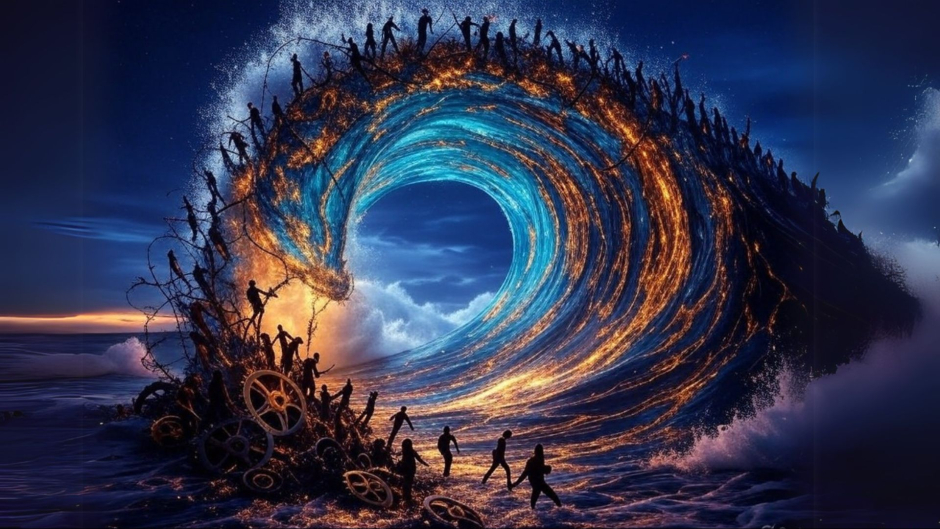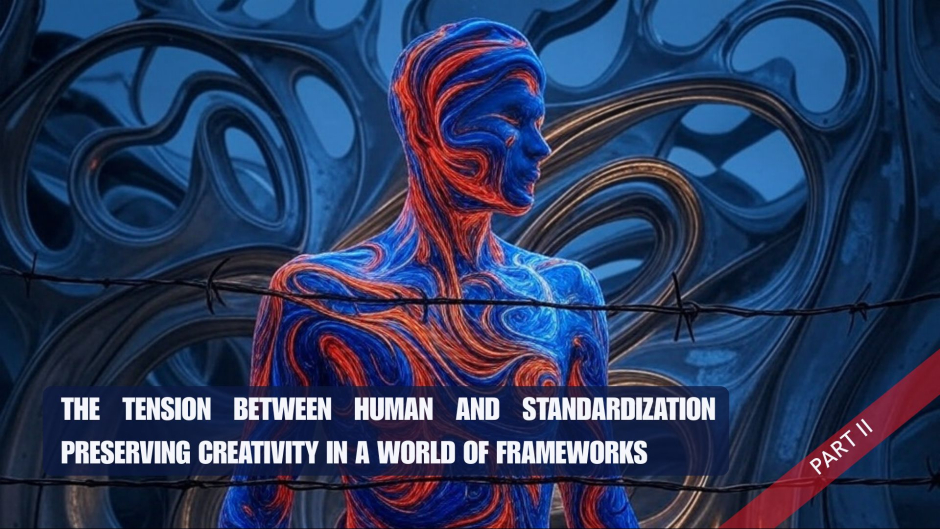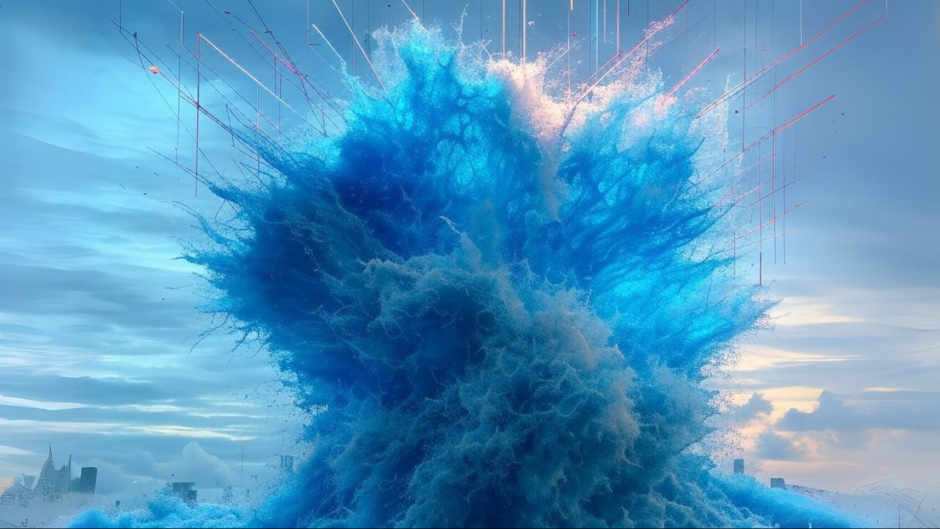Xavier Azalbert, France-Soir
The tension between the human and normatization. Preserving Creativity in a World of Frameworks - Part II
This article is the second part of a series dedicated to the exploration of frameworks, the methodological frameworks that structure our societies, our thoughts and our actions. In the first article, their history, was traced from Sun Tzu's military strategies to digital tools like Mitre Att&ck, to Jules Ferry's educational reforms. We have seen how these frameworks, born of the intelligence services and the social sciences, standardize, influence and coordinate, but also how they can limit human uniqueness. This second part plunges into this tension: the human being, with its complexity, creativity and imperfections, in the face of the norming or ("normatization") imposed by frameworks. These tools, by seeking to harmonize our behaviors through consensus, loyalism and linear logic, risk stifling what makes us strong: our disorder, our multidisciplinarity, our "madness", and our plural intelligences. As underlined in the article "The Importance of SDisorder" published in France-Soir, chaos, far from being a flaw, is a source of authenticity and innovation. By exploring figures like Leonardo da Vinci, Einstein or Socrates, concepts like the intelligence quotient (IQ) and utility quotient (QU), cases like the Hertel case, and dynamics like nonlinearity and dissension, we will see how to cultivate our uniqueness in the face of a normative matrix – and machines that threaten to outdo us out of laziness. Future articles will examine the modern uses of frameworks in information and ways to counter their influence.
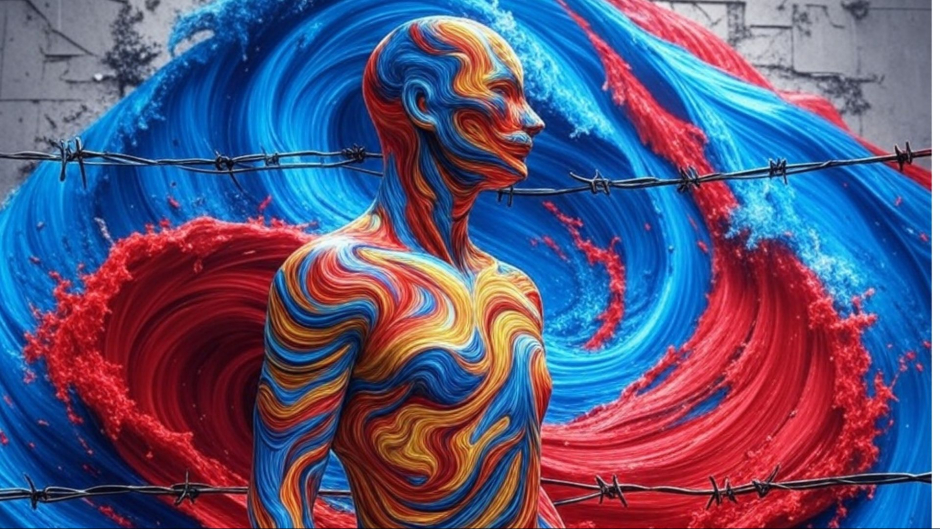
Humans, a complex, multidisciplinary and imperfect being
What makes humans so unique? Unlike a machine, whose every cog follows a predictable algorithm, humans are a kaleidoscope of emotions, thoughts, intuitions and mistakes. Its neurons weave unexpected connections, "leaps" that escape deterministic logic. This intelligence, far from being limited to Cartesian logic – this linear reasoning where each cause leads to an expected effect – is an interlacing of plural logics.
Howard Gardner, with his theory of multiple intelligences, showed that humans excel in various fields: linguistics, such as Victor Hugo's eloquence; spatial, like Le Corbusier's architectural vision; interpersonal, like Gandhi's empathy; or musical, like Mozart's sensitivity. This non-linearity, where ideas arise in zigzags, in unpredictable ruptures, is a unique strength. Science has embraced this complexity: quantum mechanics, with its intuition-defying probabilities, has revealed a universe where particles dance without following a straight path. The fractals, discovered by Benoît Mandelbrot, show chaotic patterns that repeat themselves ad infinitum, a non-linear logic, another form of harmony, which fascinates as much as it confuses. As described in "On the Importance of Disorder", "chaos is not a weakness, but an essential condition for creativity and authenticity". Humans are not smooth cogs: they are a wave, a flow of water molecules that organizes itself for a moment before dispersing, according to René Thom's theory of chaos.
This "disorder" is a different arrangement, a source of discovery.
Take Leonardo da Vinci, the Renaissance spirit who juggled painting , anatomy, engineering and philosophy. His notebooks, scribbled with flying machines and observations on the human heart, bear witness to a thought that refused the boundaries of disciplines. Michelangelo, sculptor of David, painter of the Sistine Chapel and architect of St. Peter's in Rome, also embodied this multidisciplinarity, defying the rigid frameworks of his time. Albert Einstein, a revolutionary physicist, found in music – he played the violin – and philosophy the keys to rethinking the universe.
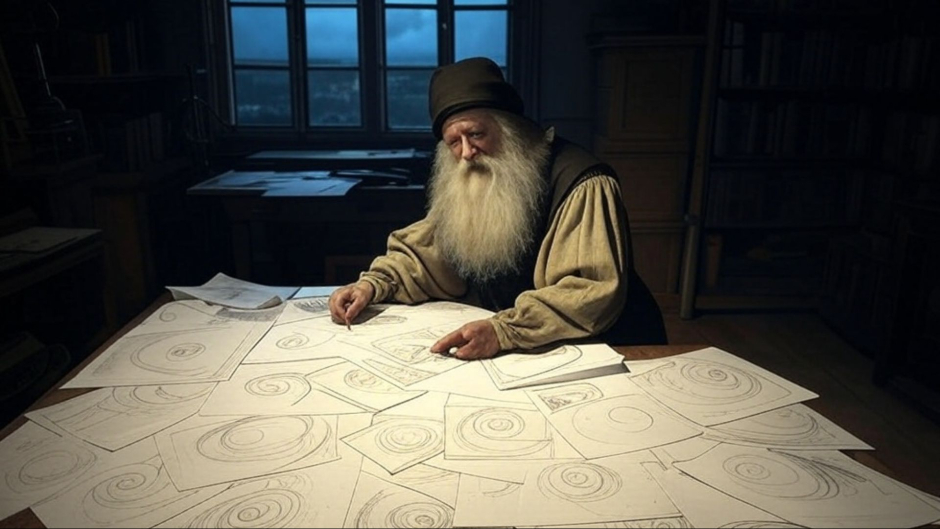
Hypatia, a mathematician and philosopher from Alexandria in the fourth century, mixed astronomy, geometry and spirituality, defying the patriarchal norms of her time. Srinivasa Ramanujan, a twentieth-century Indian mathematician, self-taught and guided by almost mystical intuitions, revolutionized mathematics with formulas that seemed to emerge from chaos. Their intelligence, which was non-linear, caused breaks in trend: Einstein, for example, broke Newton's Cartesian logic with a relativity that seemed absurd to his contemporaries.
These figures show that human creativity thrives when it transcends norms, mixing knowledge that modern frameworks compartmentalize.
And then there is "madness", this uniqueness which, in its moments of lucidity, produces flashes of genius. Vincent van Gogh, tormented by his demons, painted sunflowers and starry nights that redefined art. John Nash, a schizophrenic mathematician, developed game theory, the foundation of modern economics, in moments of clarity. Nikola Tesla, with his eccentric visions, imagined wireless electricity, a technological breakthrough inconceivable in his time. Virginia Woolf, a writer whose bipolar disorder has fueled works like Mrs. Dalloway, captured the complexity of the human soul with a non-linear sensibility. Their mental disorder, far from being an obstacle, was a door to innovation, an example of thinking where intuition and chaos surpass Cartesian reason.
"It is in this chaos, this imperfection, that the human finds his authenticity".
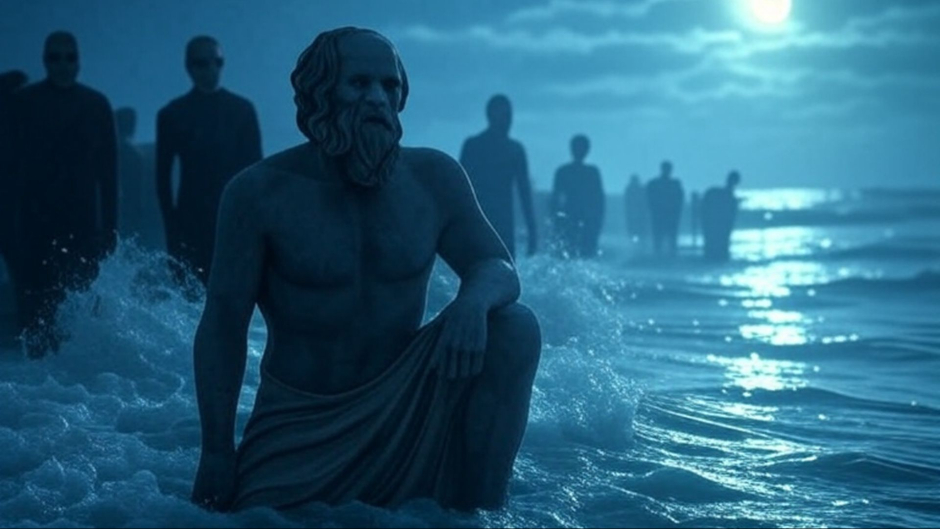
But this disorder is not limited to individual creativity: it is also expressed in disagreement. Socrates, by relentlessly questioning the established truths of Athens, defied the consensus of his time, laying the foundations of Western philosophy. His refusal to conform, even at the cost of his life, shows that disagreement is an obligation to advance thought. This non-linear disagreement breaks Cartesian patterns to open up new perspectives, like a wave that changes shape at every moment.
These examples – multidisciplinarity, madness, disagreement – reveal a truth: the human being, with his plural intelligences, is greater than the frameworks that seek to order him.
Norming of "Normatization", a matrix of consensus and loyalty
Yet, for centuries, frameworks have sought to tame this chaos. They impose norms, consensus and loyalty that, under the guise of efficiency, risk robbing us of our essence. " Our society is a prisoner of an obsession with order, which stifles authenticity in favor of predictable uniformity ." This normative "matrix", to use the image of the DISARM framework that maps disinformation campaigns, is not new. It is rooted in medieval sermons, which spread a single message to control beliefs, or in Jules Ferry's educational reforms, which standardized education to integrate citizens into the industrial age.
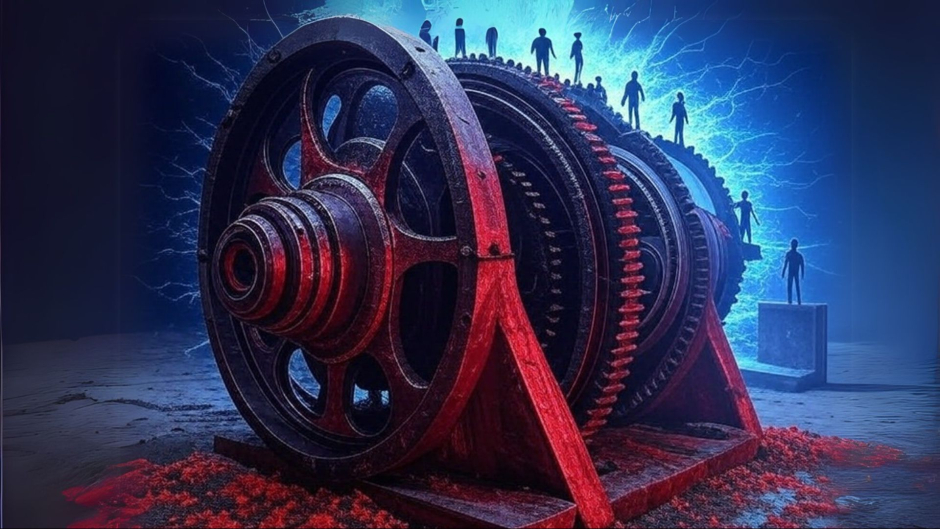
Consensus is at the heart of this matrix. Frameworks, whether it's the AIDA model in marketing, corporate protocols, or school curricula, aim to align individuals around a common vision. This consensus is formed through complex mechanisms : social pressure, where norms are internalized out of fear of rejection; institutional authority, such as scientific academies that dictate acceptable truths; or dominant narratives, amplified by modern media, from nineteenth-century newspapers to social media algorithms. In the seventeenth century, the trial of Galileo, condemned for having supported heliocentrism, illustrates this mechanism: the Church, guarantor of the geocentric consensus, rejected a non-linear truth in the name of order. Today, disinformation campaigns, orchestrated through frameworks like DISARM, manipulate perceptions to impose an artificial consensus.
Take education: Ferry's laws, in 1881-1882, organized subjects into "clusters" (mathematics, literature, science), imposing a consensus on what each child should learn. This system, anchored in a Cartesian logic, favoured linearity – learning, memorizing, reproducing – to the detriment of plural intelligences, such as intuition or creativity, which thrive in disorder. It democratized knowledge, but marginalized atypical profiles – the "dys", for example – whose talents did not fit into these boxes.
But consensus would be nothing without loyalty, this sometimes blind adherence to norms. The psychology of conformity, studied by Solomon Asch in the 1950s, shows how individuals adopt norms out of fear of rejection, even in the face of evidence to the contrary. In a famous experiment, participants denied the evidence of a line length to conform to the majority. An employee who follows company protocols without thinking may be ignoring ethical loopholes. A scientist loyal to a consensus can reject data, as in the case of the Hertel case. In the 1990s, Hans Hertel, a Swiss researcher, was censored for his studies suggesting that microwaves altered food. His work, although controversial, was stifled by a scientific consensus that refused to disagree, illustrating a danger: loyalty to norms can lead to blindness, where truth is sacrificed in the name of order.
This loyalty also conflicts with higher values, such as justice or freedom. Edward Snowden, by revealing the NSA's surveillance programs, defied the institutional norm to defend the truth, at the cost of his exile. In the pharmaceutical industry, loyalty to standardized protocols can serve conflicts of interest, where profits take precedence over public health. In the food industry, lax standards on additives, supported by lobbies, have sometimes ignored alarming studies to maintain an economic consensus. Historically and even if the story is controversial, Joan of Arc, guided by her faith and intuition, defied political and religious norms, embodying a resistance to oppressive consensus. These examples reveal the limits of loyalism: ethical, when it violates moral principles; social, when it marginalizes dissidents; practical, when it rejects innovative solutions; contextual, when it proves unsuitable for unforeseen crises.
Few people realize the extent to which this normative matrix, woven of consensus and loyalty, shapes our lives, fraom schools to laboratories, by stifling human authenticiy.
Measuring the human: IQ, QU and the limits of categorization
Frameworks don't just organize: they measure the human, often by reducing them to boxes. This measure is based on a Cartesian logic, which favours linearity and predictability, ignoring the plural intelligences that make up human wealth. The intelligence quotient (IQ), developed by Alfred Binet in 1905, is an emblematic example. Designed to assess children's cognitive abilities, it focuses on logic and memory, but ignores creativity, multidisciplinarity or ethics. An inventor like Thomas Edison, often mediocre in school, would have been underestimated by IQ, yet his innovations, such as the light bulb, transformed the world. Alan Turing, the father of computer science, was an atypical mind whose mathematical genius eluded academic standards. Science itself has shown the limits of this logic : quantum mechanics, with its intuition-defying probabilities, or chaos theory, with its unpredictable systems, have revealed that Cartesian reason fails to grasp complexity.
IQ, by imposing a linear consensus on intelligence, marginalizes the multiple forms of intelligence – emotional, intuitive, creative – described by Howard Gardner. A musician like Mozart displayed musical intelligence; a leader like Gandhi, interpersonal intelligence.
Faced with these limitations, the utility quotient (QU), proposed by Didier Audebert in "Utility quotient: Let's become more useful every day!", offers an alternative. By valuing social impact – for example, a woman organizing a solidarity network in her neighborhood, a teacher sharing her knowledge voluntarily, or a teenager launching an ecological initiative – Q recognizes ethical and interpersonal intelligences that IQ ignores. As highlighted in a Dys article on Dys, education systems, obsessed with IQ, often direct "dys" students (dyslexic, dyspraxic) towards manual courses, ignoring their potential for social utility. The QU, by valuing authenticity and contribution, challenges this normative consensus.
Personality frameworks, such as the Myers-Briggs Type Indicator (MBTI), follow a similar logic. Developed in the 1940s, the MBTI classifies individuals into 16 types (e.g., INTP, ESFJ), imposing a consensus on what a "good" personality is. His evolution towards the Big Five (openness, conscientiousness, extroversion, agreeableness, neuroticism) is more nuanced, but remains normative, unable to grasp human fluidity or "madness". A writer like Franz Kafka, with his tormented sensitivity, or a musician like Kurt Cobain, with his emotional intensity, would not fit into these boxes. These frameworks, in seeking to linearize human complexity, reject the plural intelligences that thrive in disorder and non-linearity.
It is in this chaos, this imperfection, that the human finds his authenticity. Disagreement with these norms is essential to recognizing human diversity, whether it is Leonardo da Vinci's multidisciplinarity or Tesla's eccentricity.
Codifying creativity, a normative paradox
If humans are creative chaos, can we codify our creativity without destroying it? Modern frameworks, such as design thinking, try to structure innovation in stages (empathy, ideation, prototyping). But this approach, while useful, can curb spontaneous ideas, those that arise in a moment of disorder. " It is in chaos, not in order, that real breakthroughs are born." Non-linearity, at the heart of creativity, allows for trend breaks – those moments when an idea defies Cartesian logic to open up a new paradigm. Science has progressed thanks to these ruptures: quantum mechanics has shattered the idea of a linear universe; Benoît Mandelbrot's fractals, with their chaotic patterns, revealed the beauty of disorder. In art, Pablo Picasso's cubism overturned pictorial conventions, a non-linear rupture that redefined modernity.
Chaos theory, with its metaphor of water molecules forming a wave before dispersing, illustrates this disorder: a fertile chaos that drives innovation.
"Madness", in its moments of lucidity, produces flashes of genius. Nikola Tesla's visions, perceived as eccentric, anticipated wireless electricity. John Nash's equations, developed in periods of clarity, redefined economics. These non-linear breakthroughs show that human logic is not a straight path, but a labyrinth where intuition, error and chaos intersect. Similarly, disagreement with normative consensus is a driver of progress. Socrates, in defying Athenian truths, laid the foundations of philosophy. Galileo, by opposing the Church, revolutionized astronomy. Charles Darwin, by publishing "The Origin of Species" in 1859, caused a break by defying the creationist consensus, a non-linear idea that transformed biology. Ignaz Semmelweis, in the nineteenth century, defied doctors by proving that hygiene reduced infections, a truth rejected by the medical consensus of the time.
These figures show that creativity thrives when it rejects loyalty to norms.
However, frameworks seek to harmonize, to make predictable. In schools, standardized tests favor compliant answers, discouraging divergent thinking essential to multidisciplinarity. In business, rigid protocols marginalize unconventional ideas. This linear logic, inherited from Descartes, ignores the breaks in trends that have shaped history – from Einstein's relativity to Van Gogh's modern art. The invention of the Post-it note, born from a "failed" adhesive by Spencer Silver at 3M, illustrates this paradox: it is a failure, a disorder, that has led to an innovation. Similarly, the French Revolution, a social chaos, upset the monarchical order to open a new era.
Codifying creativity is to risk reducing it to a simulacrum of order, far from its chaotic essence.
Preserving human uniqueness: disagreement, values and authenticity
Faced with this normative matrix, how can we preserve human uniqueness? First, by celebrating disorder. Disorder is not a defect, but a "different arrangement," a wave that brings new possibilities. Pedagogies such as Maria Montessori's, which encourages autonomy and creativity, show that it is possible to structure learning without stifling individuality. By valuing plural intelligences – logical, emotional, creative – and non-linear thinking, schools could unleash the potential of atypical profiles, whether it is a future Leonardo da Vinci or a "dys" student capable of causing a break in trend. An interdisciplinary education, mixing science, art and philosophy, could encourage these unpredictable leaps, such as those of Hypatia or Ramanujan. Programs that incorporate collaborative projects, where students explore problems without predefined solutions, would promote creativity and dissension.
Secondly, disagreement must be made an ethical obligation. Edward Snowden, in defying mass surveillance, has prioritized truth over institutional loyalty. Hans Hertel, by persisting in the face of censorship, defended science against a rigid consensus. Grassroots movements, such as the normative climate protests led by Greta Thunberg or the actions of the Anonymous collective, show that debate and dissent are vital to challenging the established, often linear, norms that hold back progress. They allow us to see imperfections but are also subject to the phenomena of capture and instrumentalization that we will discuss in another chapter.
These voices, by challenging economic or political consensus, embody a non-linear thinking that pushes us to rethink the world. These acts of resistance show that disagreement, far from being destructive, is a bulwark against normative blindness. Higher values – justice, freedom, truth – must take precedence over conformism.
The limits of loyalty/loyalism are clear: ethically, it can betray principles; socially, it marginalizes dissidents; in practice, it rejects innovation; Contextually, it fails in the face of crises.
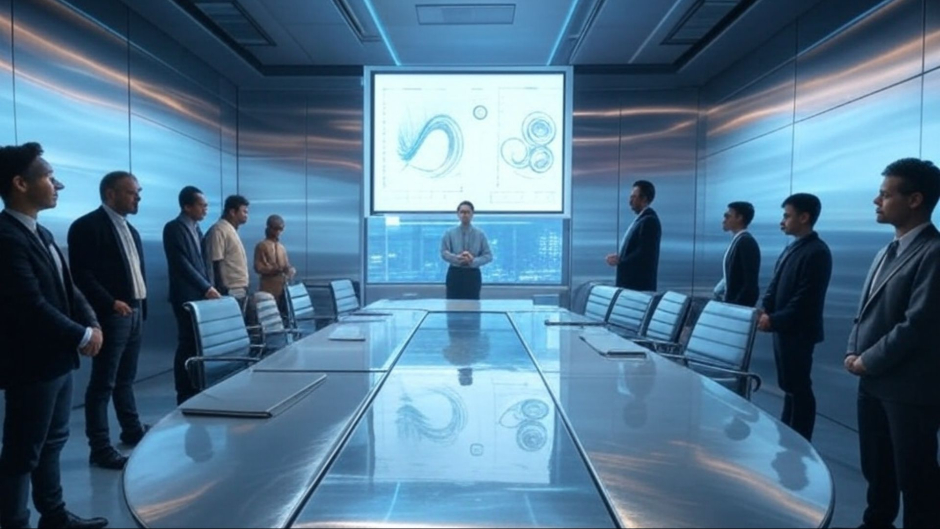
Rethinking evaluation frameworks is another avenue. Norming or "normatization" can never codify the plurality of human intelligences, whether it is Tesla's intuition, the empathy of a volunteer, or the spatial vision of an architect. The QU, by valuing social impact, could be integrated into education systems to recognize contributions beyond academic performance. Tools such as the Big Five could be adapted to capture the fluidity of personalities, without imposing a rigid consensus. A more open science, respecting the Hertel jurisprudence, should publish non-compliant research, favouring multidisciplinarity in the manner of Leonardo da Vinci, who combined observation and intuition.
Authenticity is an essential key. By taking the time for introspection, far from normative frameworks, individuals can rediscover their inner chaos, the one that allowed Nikola Tesla to imagine the future or John Nash to solve puzzles. Institutions must create spaces for atypical profiles – the "crazy", the multidisciplinary, the dissidents – such as Michelangelo, who defied artistic conventions, or Einstein, who rethought the universe. But there is an urgency: our survival instinct. Machines, with their deterministic algorithms, thrive within normative frameworks. Predictive algorithms, such as those in digital platforms or automated health systems, excel at analyzing linear patterns, but fail to replicate nonlinear intuition or creative breakthroughs. If we, out of laziness, allow ourselves to be locked into these frameworks, we risk losing what distinguishes us: our creativity, our non-linearity, our ability to provoke ruptures. Steve Jobs, with his unconventional thinking mixing technology, design and philosophy, caused a break in the trend by defying the norms.
We must cultivate this creativity, this debate, this dissension, to remain stronger than the machines.
Embracing chaos to liberate the human
Frameworks, with their promise of order and efficiency, are powerful tools, but they carry a risk: that of suffocating what makes humanity. The consensus they impose, the loyalty they demand, and the linear logic they favor conflict with our disorder, our multidisciplinarity, our "madness." Our plural intelligences, our breaks in trends, our ability to think in a non-linear way and to provoke debate are forces that normatization can never codify. "It is in chaos – that of Socrates defying Athens, of Leonardo da Vinci sketching impossible machines, or of Snowden revealing hidden truths – that humans find their authenticity."
Higher values, whether it is justice or freedom, call us to disobey when norms blind us.
By celebrating disorder, cultivating debate and dissension, valuing frameworks like the QU, we can transform frameworks into tools that amplify, rather than limit, our creativity. Without this vigilance, we risk, out of laziness, letting machines, with their linear logic, surpass our creative chaos. Our survival depends on our ability to embrace our non-linearity, our plural intelligences, and our courage to defy norms. The next article in this series will explore the modern uses of frameworks in information management, where systematic and probabilistic approaches are redefining our relationship to truth.
Until then, let's not forget: humans are not machines. There are waves, a magnificent chaos, and it is in this disorder that they write their history.
